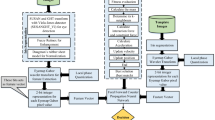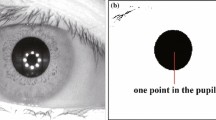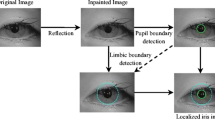Abstract
In recent years, non-cooperative iris recognition has gained a major role in biometric authentication system. However, owing to images captured in non-cooperative environments, it is quite a difficult job, for these images have specular reflections, blur, occlusions, and are off-axis. This research introduces an efficient non-cooperative iris recognition system developed for hierarchical collaborative representation-based classifier (HCRC). The proposed method includes three stages. The first stage involves image preprocessing. Initially, hybrid median filtering is done to reduce noise and to improve the image quality. Then, segmentation of the abnormal non-cooperative iris image is carried out by applying Geodesic Region-based Active Contour Level-set algorithm and threshold-based segmentation algorithm. In the second stage, 2 × 2 block-based Local Ternary Pattern (LTP) is applied to the segmented image. This gives upper and lower LTP histogram blocks. The final feature vector is obtained by combining these two blocks. In the third stage, the feature vectors are applied to the HCRC for classification on the basis of the iris database. The proposed iris recognition technique proved itself by achieving 98.60, 0.095 and 0.096 accuracy, false acceptance rate and false rejection rate, respectively.










Similar content being viewed by others
References
Jain AK, Ross A, Prabhakar S (2004) An introduction to biometric recognition. IEEE Trans Circuits Syst Video Technol 14(1):4–20
He Z, Tan T, Sun Z, Qiu X (2009) Toward accurate and fast iris segmentation for iris biometrics. IEEE Trans Pattern Anal Mach Intell 31(9):1670–1684
Murillo-Escobar MA, Cruz-Hernández C, Abundiz-Pérez F, López-Gutiérrez RM (2015) A robust embedded biometric authentication system based on fingerprint and chaotic encryption. Expert Syst Appl 42(21):8198–8211
Daugman J (2007) New methods in iris recognition. IEEE Trans Syst Man Cybern Part B (Cybernetics) 37(5):1167–1175
Czajka A, Bowyer KW, Krumdick M, VidalMata RG (2017) Recognition of image-orientation-based iris spoofing. IEEE Trans Inf Forensics Secur 12(9):2184–2196
Barpanda SS, Majhi B, Sa PK (2015) Region based feature extraction from non-cooperative iris images using triplet half-band filter bank. Opt Laser Technol 72:6–14
Yahya AE, Nordin MJ (2010). Non-cooperative iris recognition system: a review. In: 2010 International Symposium in Information Technology (ITSim), vol 1. IEEE, pp 1–5
Proenca H, Alexandre LA (2007) Toward noncooperative iris recognition: a classification approach using multiple signatures. IEEE Trans Pattern Anal Mach Intell 29(4):607–612
Yang K, Du EY (2011) A multi-stage approach for non-cooperative iris recognition. In: 2011 IEEE International Conference Systems, Man, and Cybernetics (SMC). IEEE, pp 3386–3391
Proença H, Alexandre LA (2006) Iris segmentation methodology for non-cooperative recognition. IEE Proc Vis Image Signal Process 153(2):199–205
Hu Y, Sirlantzis K, Howells G (2015) Improving colour iris segmentation using a model selection technique. Pattern Recogn Lett 57:24–32
Shamsi M, Saad PB, Ibrahim SB, Kenari AR (2009) Fast algorithm for iris localization using Daugman circular integro differential operator. In: International Conference of Soft Computing and Pattern Recognition. SOCPAR’09. IEEE, pp 393–398
Zhang J, Hu J (2008) Image segmentation based on 2D Otsu method with histogram analysis. In: 2008 International Conference on Computer Science and Software Engineering, vol 6. IEEE, pp 105–108
Shah S, Ross A (2009) Iris segmentation using geodesic active contours. IEEE Trans Inf Forensics Secur 4(4):824–836
Liu N, Li H, Zhang M, Liu J, Sun Z, Tan T (2016) Accurate iris segmentation in non-cooperative environments using fully convolutional networks. In: 2016 International Conference on Biometrics (ICB). IEEE, pp 1–8
Yahya A, Jan NM (2010) Accurate iris segmentation method for non-cooperative iris recognition system. J Comput Sci 6(5):527–532
Nithya AA, Lakshmi C (2019) On the performance improvement of non-cooperative iris biometrics using segmentation and feature selection techniques. Int. J. Biometrics 11(1):1–21
Abdullah MA, Dlay SS, Woo WL, Chambers JA (2017) Robust iris segmentation method based on a new active contour force with a noncircular normalization. IEEE Trans Syst Man Cybern Syst 47(12):3128–3141
Al-Waisy AS, Qahwaji R, Ipson S (2018) A multi-biometric iris recognition system based on a deep learning approach. Pattern Anal Appl 21:783
Zhao D, Luo W, Lio R, Yue L (2018) Negative iris recognition. IEEE Trans Dependable Secure Comput 15(1):112–125
Appia V, Yezzi A (2011) Active geodesics: region-based active contour segmentation with a global edge-based constraint. In: IEEE International Conference Computer Vision (ICCV), pp 1975–1980
Chang Y-T, Shih TK, Li Y-H, Kumara WGCW (2018) Effectiveness evaluation of iris segmentation by using geodesic active contour (GAC). J Supercomput. https://doi.org/10.1007/s11227-018-2450-2
Kennedy J (2011) Particle swarm optimization. In: Sammut C, Webb GI (eds) Encyclopedia of machine learning. Springer, New York, pp 760–766
Vo DM, Lee SW (2018) Robust face recognition via hierarchical collaborative representation. Inf Sci 432:332–346
Jan F, Usman I, Agha S (2012) Iris localization in frontal eye images for less con-strained iris recognition systems. Digital Signal Process 22:971–986
Jan F, Usman I, Agha S (2013) Reliable iris localization using Hough transform, histogram-bisection, and eccentricity. Signal Process 93:230–241
Baskar M, Gnansekaran T (2017) Multi model network analysis for improved intrusion tracing towards mitigating DDoS attack. Asian J Res Soc Sci Humanit 7:1343–1353
Baskar M, Gnansekaran T (2017) Developing efficient intrusion tracking system using region based traffic impact measure towards the denial of service attack mitigation. J Comput Theor Nanosci 14:3576–3582
Author information
Authors and Affiliations
Corresponding author
Additional information
Publisher's Note
Springer Nature remains neutral with regard to jurisdictional claims in published maps and institutional affiliations.
Rights and permissions
About this article
Cite this article
Rajeev Kumar, M., Arthi, K. An effective non-cooperative iris recognition system using hierarchical collaborative representation-based classification. J Supercomput 76, 5835–5848 (2020). https://doi.org/10.1007/s11227-019-03007-0
Published:
Issue Date:
DOI: https://doi.org/10.1007/s11227-019-03007-0




